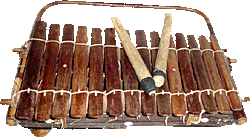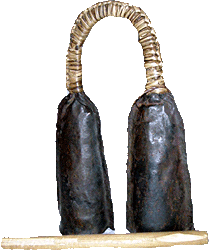|
|
As a professional African musician, Noah:
-
Plays many instruments
-
Makes African instruments
-
Sings
-
Composes music
-
has researched into and published works on traditional
music makers in his country, Cameroon
-
plays in World Music bands
-
gives concerts and teaches abroad
Noah's music is featured on two CDs. Click Here
for details
In workshops, performances and demonstrations, live African music is played on a variety of authentic traditional African instruments, many of which are hand-made by Noah
from authentic natural African plants. (Please see the table below)
 This exotic music evokes the soul and spirit of Africa in all its moods from dawn to dusk, from the immensity of the
desert and the mystery of the Savannah to the exuberance of the rain forest.
This exotic music evokes the soul and spirit of Africa in all its moods from dawn to dusk, from the immensity of the
desert and the mystery of the Savannah to the exuberance of the rain forest.
Noah has vast experience of running workshops in schools, arts and cultural centres, libraries, holiday programs, for special events
such as community and charity events and for corporate clients.
During the hands-on workshops, everyone has the opportunity to make music together with the Master
Musician, using beautiful crafted instruments. Noah’s pedagogic technique of African polyrhythmics
ensures everyone, regardless of their previous experience, feel both relaxed and stimulated at their own individual level of ability. The complex “I haven’t got any rhythm” is proved to be untrue, as everyone has rhythm, once freed from inhibition.
The participants experience not only the thrill of making music, but also learn:
-
how to listen carefully to the sounds of music
-
to follow instructions
-
to play musical instruments
-
how to play music together in a group
-
to sing some songs
-
how instruments are made
-
to compose music
The songs are mostly in the Beti language (from Cameroon), some composed by Noah. The audience discovers how the talking/log drums communicate their verbal messages through drumbeats and they learn some of the sounds of this fascinating tonal language.
|

Click on the picture to read more
|
Balafons (Mendjang), are the traditional xylophones of the
Beti people of Cameroon, West Africa.
They are made of wooden keys with natural gourds as resonators.
A balafon ensemble usually consists of 4 to 6 balafons, each
having different individual temperaments and functional names.
We have a complete page about this instrument.
Click Here to read it. |
|
A childrens’ favourite!
This African drum, which is hollowed out of a whole tree trunk, is used for both music and communication. Played with two sticks, its powerful sounds can carry over 10 miles (16 km).
Children queue up to have a go on the King Kong! |
 |
 |
Made of wood, with animal skins at both ends, there are strings that, when squeezed, pull the skins in order to vary the pitch of the sound. |
|
Famous worldwide, originally from West Africa, it’s the main percussion instrument we use in our drumming workshops. It’s made of wood, with a goat skin cover, which is tightened by strings and played with bare hands. Its rhythms, which are both therapeutic and invigorating, naturally incite everyone to dance. |
 |
 |
Ancient harp from the South of Cameroon, it’s made of a bamboo cane, strings and calabashes, which serve as resonators. Its exotic sounds are compelling. Used to accompany the recital and songs of the traditional African storyteller, it’s an authentic feature of our interactive storytelling sessions. |
|
Handheld instruments, usually played with both thumbs. It consists of a resonator, generally made out of a gourd, and bamboo or metal keys. It makes enchanting and soft music, adored by children. |
  |
 |
Instrument made of wood and strings, it has soft sounds and is used for storytelling. Its quite common throughout Africa, designed in various shapes and sizes. |
|
Made out of two metal gongs with two individual sounds, one low and one high. It’s played with a wooden stick. |
 |
 |
There are many different types, they mostly consist of natural fruits, pods and gourds with their seeds inside. Easy and fun to play, they’re good for keeping the basic beat.
Made out of bamboo or wood, they’re short and either flat or round. They’re used in pairs to enhance the beat in music and also for dancing. |
| |
|
|
|


 Workshops, Performance and African Instruments
Workshops, Performance and African Instruments This exotic music evokes the soul and spirit of Africa in all its moods from dawn to dusk, from the immensity of the
desert and the mystery of the Savannah to the exuberance of the rain forest.
This exotic music evokes the soul and spirit of Africa in all its moods from dawn to dusk, from the immensity of the
desert and the mystery of the Savannah to the exuberance of the rain forest.








